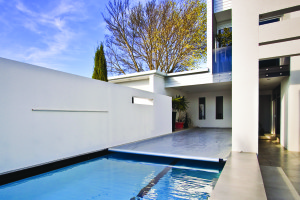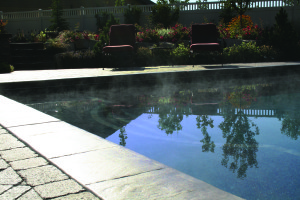Winning the game against evaporation

In colder climates, energy costs are some of the highest ongoing expenses for outdoor pool and swim spa owners. Pool water gains heat from the pool heater (either gas, electric or solar) and directly from the sun. Pool water loses heat through radiation, conduction, convection and evaporation. The first three typically account for 30 per cent of thermal loss. On an uncovered pool, the remaining 70 per cent is typically caused by evaporation—the number one enemy of an efficient pool.
Wind, humidity, air/water temperature and pool activity all contribute to the evaporation level. In turn, evaporation takes valuable heat, chemicals and, most obviously, treated water out of the pool. Each evaporating litre of 27 C (87.6 F) pool water can take over 2,000 British thermal units (Btus) of heat with it. All of the wasted resources need to be replaced to get the pool water back to ideal levels, balance and temperature. Even the most energy-efficient pool heater has to work diligently to replace the heat.

Adding a vapour barrier, such as a vinyl safety cover, can prevent the energy, chemical and water loss from evaporation when the pool or swim spa is not occupied. This also means the pool equipment can be appropriately sized for the pool’s needs and the owner’s budget.
While above-ground pools experience a higher percentage of thermal loss from conduction, they will also have evaporative losses similar to inground pools. These pools can still benefit from a cover system as long as there is room on a deck surface for parallel guides to be installed along the pool side.
For indoor pools and spas, managing humidity levels is one of the biggest challenges. Dehumidification systems can be quite an investment to install and operate; however, including a cover system can dramatically cut down on dehumidification needs.
“The difference in humidity levels was quickly apparent,” says Jack Clark, a tri-athlete who uses his indoor current pool for training and family recreation. “After we finished construction, there were a few days when the pool was heated but uncovered. Water was dripping off of the walls inside the basement and the outside wall was wet to the touch. The building was sweating. Once we finished the cover installation and were able to keep the pool covered, the humidity went away.”






